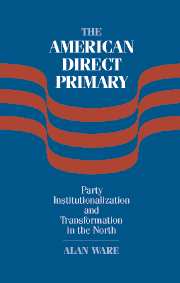Book contents
3 - Legal Control of Party Activity
Published online by Cambridge University Press: 16 July 2009
Summary
One of the most distinctive features of American political parties during the twentieth century was the extent to which party activities had come to be regulated by law. Two aspects of this are especially important in relation to the introduction of the direct primary. In many states more than a decade of extensive regulation of the nomination process usually preceded the introduction of the direct primary. Often the direct primary was the culmination of repeated attempts by legislators to provide for nomination procedures that worked better than the existing ones. Second, in making direct primaries mandatory, state governments turned a process that, unquestionably, had been that of a private association into something resembling a public election; in doing so, inevitably they generated controversies about the nature of American political parties. Were they still private associations, or were they public agencies? This chapter examines how party nomination procedures became subjected to legal control, and why such legal control was necessary in the United States.
Candidate Selection in the Nineteenth Century
From the days of the Jacksonian democracy onward, most counties in the United States employed a system of nominating candidates that political scientists later would describe as one involving caucuses and conventions. That is, it was a two-stage process. At the first stage party supporters would select delegates to represent them at a convention – a county convention for county level offices, or a state convention for state level offices, and so on.
- Type
- Chapter
- Information
- The American Direct PrimaryParty Institutionalization and Transformation in the North, pp. 57 - 94Publisher: Cambridge University PressPrint publication year: 2002
- 1
- Cited by



